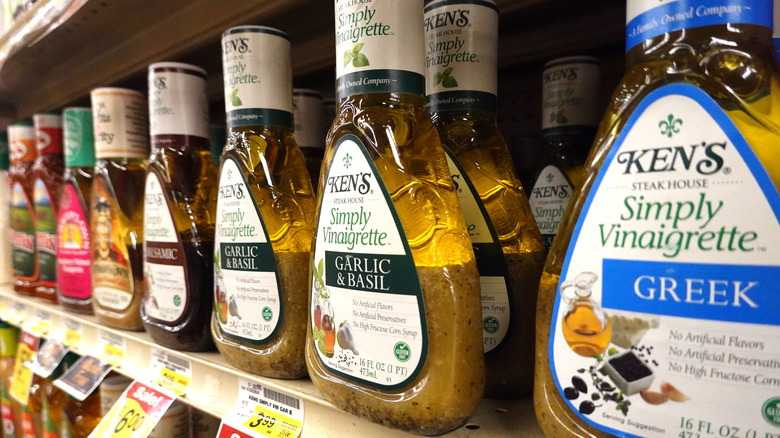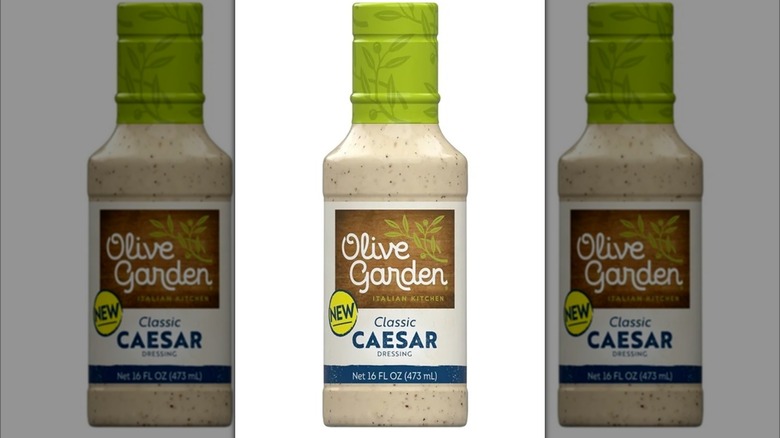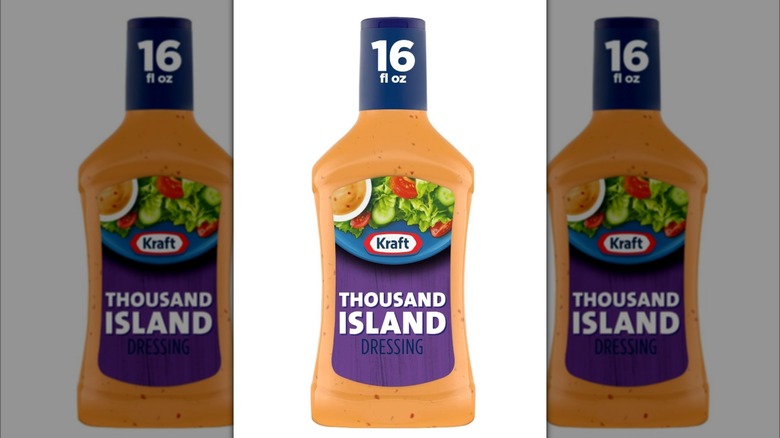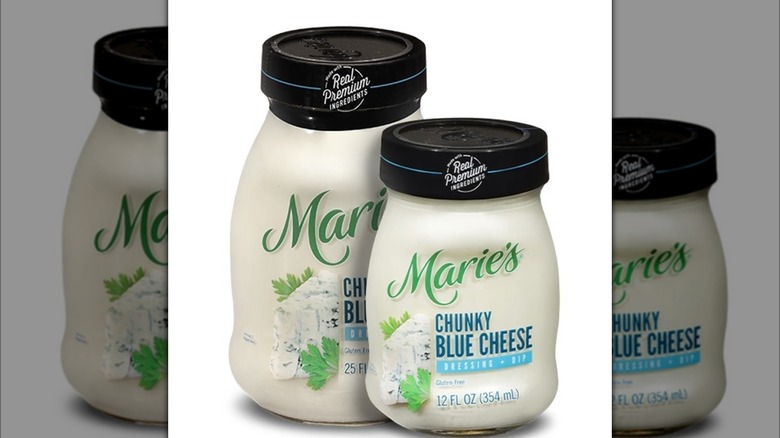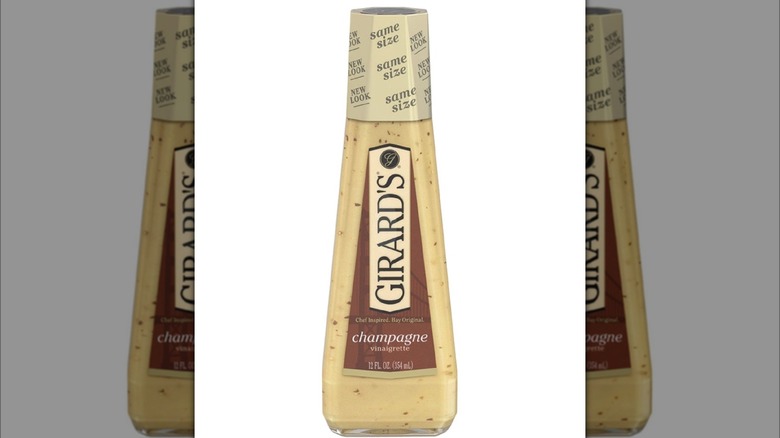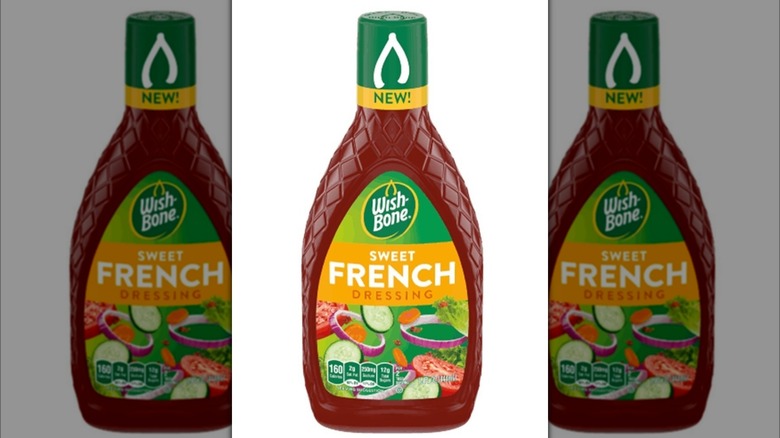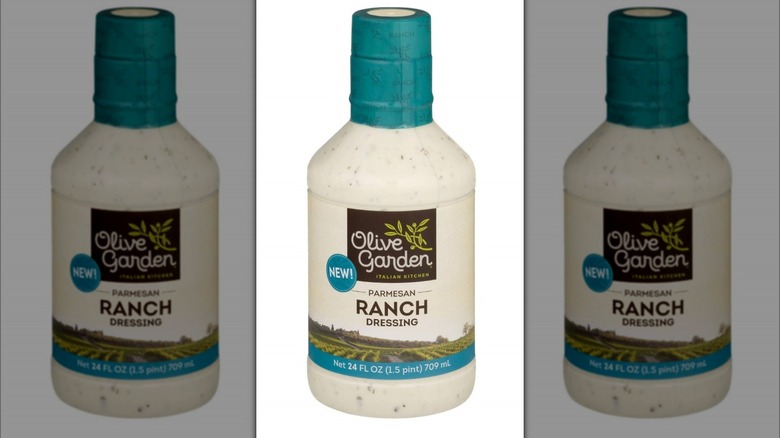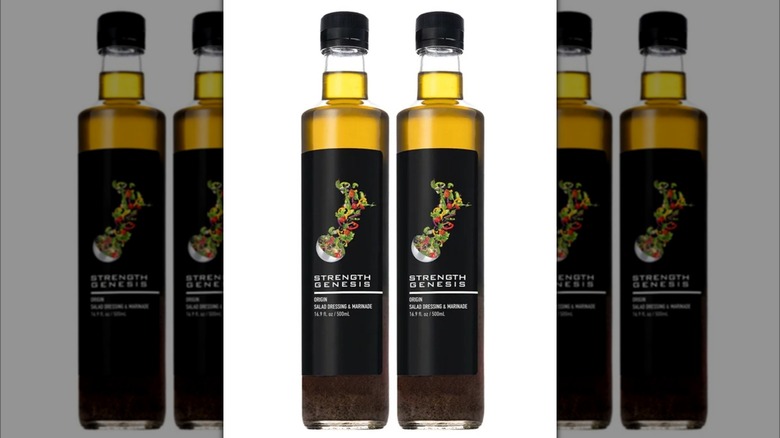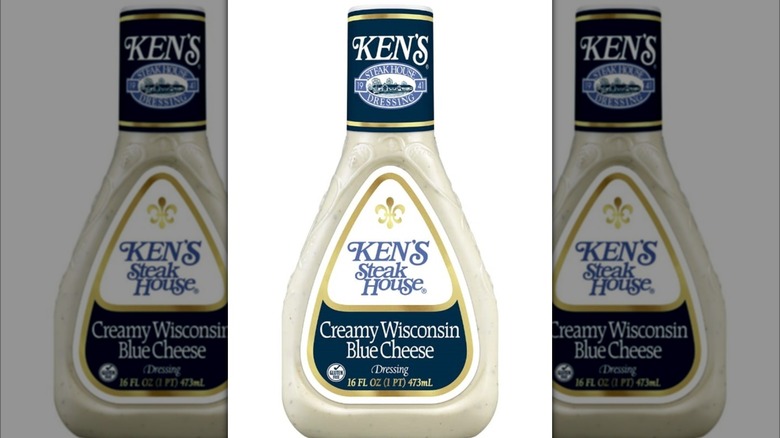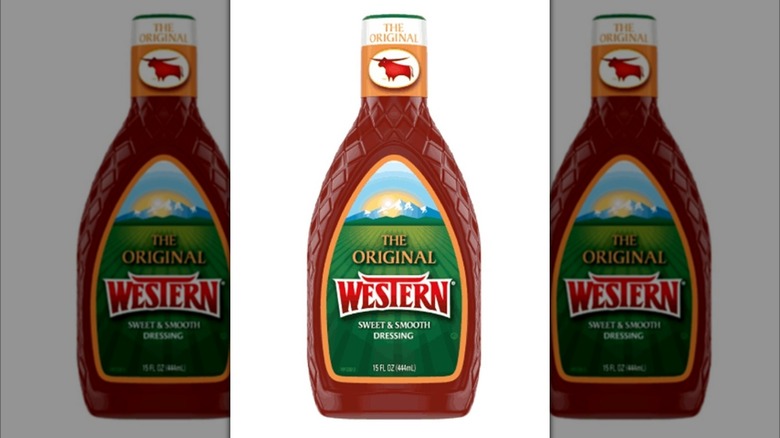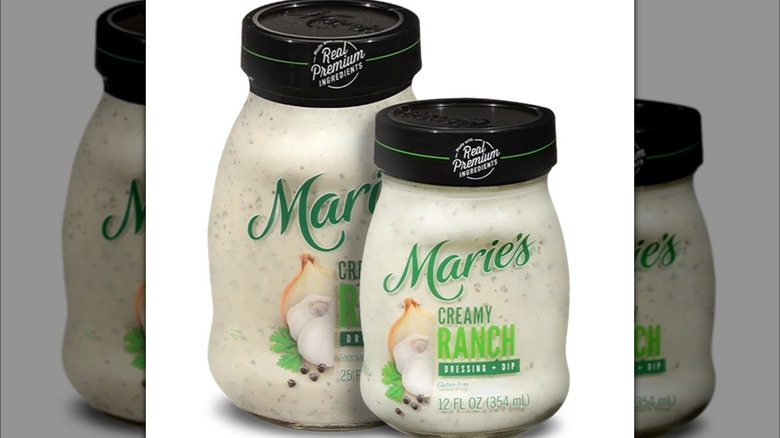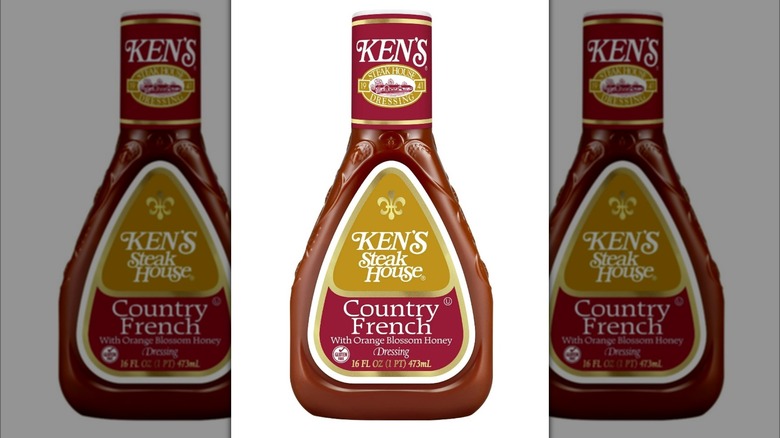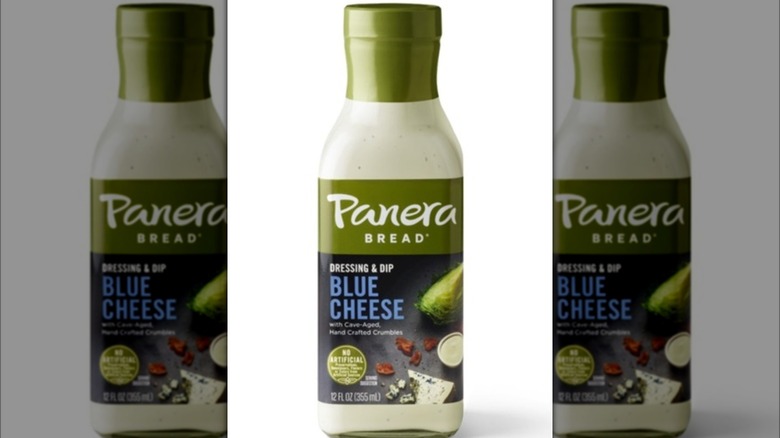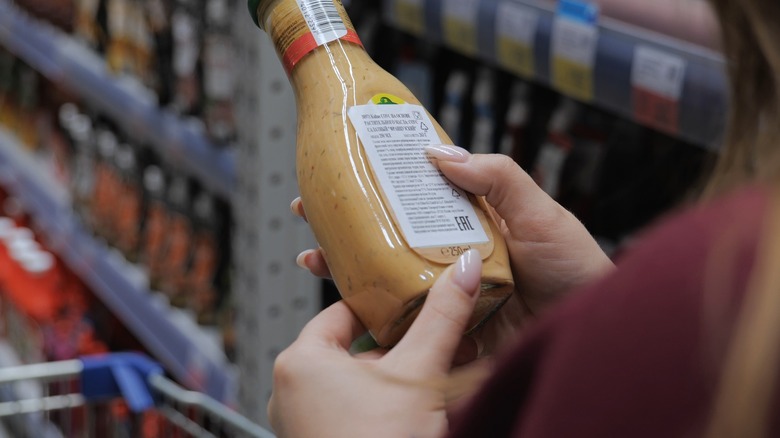12 Unhealthiest Salad Dressings You Can Buy
Salad dressing may seem like an add-on that you can easily leave off to save a heap of unnecessary calories, fat, sugar, and sodium. But anyone who's ever eaten dry salad as a form of nutritional self-care understands that if you intend to eat your way to the bottom of the bowl, dressing is non-negotiable, no matter which type you prefer. While some salad dressings are top-tier options for minimizing your intake of unadvisable ingredients, there's a wild world of unhealthy salad dressings on grocery store shelves that can easily turn your healthy salad into a nutritional catastrophe with one slip of the bottle.
If you've never played Spin the Bottle to read the nutrition facts and ingredient selection to see what's really in salad dressing, then it's high time you learned what makes some selections unhealthy options even though they add flavor and panache to your veggie cache. We've done the detective work to apprehend the shadiest characters lurking in the salad dressing aisle, flagrant lettuce frostings that don't have as much concern for your well-being as they should. By seeking out the products with the highest calories, as well as fat, sugar, and sodium content — plus the weird additives that needlessly complicate matters — we've compiled a Least Wanted list of the dressings with the worst nutrition offenses around. You'd be wise to watch your step when walking past these shady shakers next time you're prowling for condiments.
1. Olive Garden Classic Caesar
If the idea of an honest-to-goodness home version of Olive Garden Classic Caesar salad dressing sounds too good to be true, maybe that's because it's too good to be healthy for you. It may be what makes Olive Garden salad so delicious, but that doesn't mean you should douse your greens in it whenever you get the chance. If anything, it should mean that you come to your senses before you toss a bottle in your cart and find something more suitable to provide better nourishment while adding flavor to your romaine and croutons.
At 100 calories per serving, this dressing doesn't have the highest caloric content on the chart. But it does pack in 10 grams of fat, 2 of which are saturated, which soaks up 10% of your recommended daily consumption. Sodium shows up on the scene at a total of 340 milligrams, or 15% of your allotment per day. At this point, you haven't even added fresh Parmesan to your salad. Wouldn't you rather find a less-offensive dressing to keep the situation on the lighter side? It also contains eggs, soy, milk, and anchovies, problematic elements for anyone with allergies to those ingredients. Et tu, Olive Garden Caesar?
2. Kraft Thousand Island
A home version of the timeless salad bar favorite at cafeterias and all-you-can-eat buffets around the U.S., Kraft Thousand Island dressing is one of those strange flavor blends that sounds terrible on paper but somehow works when squeezed over iceberg lettuce. That doesn't make it a healthy option, though; few recipes that include mayonnaise ever are.
A serving of this chunky dressing and you're in for a high-calorie no-good time — 130 calories, to be exact. Those come with 12 grams of fat, 2 of which are saturated, taking up around 15% of your daily total fat intake and 10% of your saturated intake. If you're adding this like secret sauce to a burger, you've likely just maxed out your totals in a single meal. With 270 milligrams of sodium, or almost 12% of your daily amount, coming along for the ride in addition to 3 grams of sugar and several chemical preservatives, you've set sail for a nutritional tidal pool that's bound to drag you under. Choose a salad dressing with a few less islands instead. Your internal systems will thank you.
3. Marie's Chunky Blue Cheese
Marie's salad dressings are premium versions of the same flavors you can find up and down the condiment aisle. So, when a deluxe option like Chunky Blue Cheese hits the collection, prepare for a mix of ingredients that can play havoc with your health if you're not cautious. This is a dressing that takes creamy to the outer reaches of what's advisable in an effort to maximize flavor, though it does so at the expense of its own nutritional aspects.
Practically every ingredient on the list is a source of fat; soybean oil, blue cheese, sour cream, and egg yolks all contribute. Only non-fat buttermilk keeps things skimmer than they would be otherwise, and a serving still tallies up at 18 grams of fat, 3.5 of which are saturated. That's 23% of your total fat and 18% of your saturated fat held in 2 tablespoons of blue cheese dressing. It's like the gold standard of nutritional compromise, and your health is a much more crucial commodity than a well-dressed salad.
4. Girard's Champagne Vinaigrette
Ah, Girard's Champagne Vinaigrette ... it sounds luxurious, doesn't it? Sort of like a salad dressing used by the rich and famous to make their baby radicchio more palatable. The luxury in the name extends to the indulgence of the ingredients, which of course has an impact on the nutritious nature of the dressing, or lack thereof. It sounds like a way to take your simple salad into the realm of stardom, like a dish you'd find on the dinner table of a crown prince or a TikTok comedian. But you have bigger health plans on your mind, and Girard's isn't going to help you achieve your goals.
Why not, you ask? Because 150 calories, 15 grams of fat, and 420 milligrams of sodium per serving aren't exactly of benefit to your nutritional practices — especially not when the recipe includes sugar, molasses, and white wine with sulfites. There's also MSG, which may not be ruled a troubling ingredient overall anymore but can still cause reactions in certain eaters. All combined, it's the equivalent of a wild night in a salad dressing that might come with a headache, even if you don't empty the bottle.
5. Wish-Bone Sweet French
Wish-Bone Sweet French dressing calls out its sugary nature with a name that seems all too proud. It's distressing enough to see high fructose corn syrup as the first ingredient in the formula. You're eating salad to be healthier; topping it with a sweetener designed for the soft drink and candy selections shouldn't be an option. Wish-Bone didn't get the memo, which means this plus apple juice concentrate is netting you 12 grams of added sugar, or 24% of your daily intake. In a salad dressing. On your healthy salad. Gross.
But wait — there's more! You'll also get 12 grams of fat (15% of an entire day's allotment), 2 grams of which are saturated (10% of a day's worth), and 250 milligrams of sodium (11% of your desired consumption). Knowing all of this disappointing anti-nutritional info makes adding Wish-Bone Sweet French to your dinner plans enough to make you wonder why you're even eating kale in the first place. Try a squeeze of lemon, a spritz of olive oil, and a sprinkle of pepper for a homemade dressing with much more beneficial profile.
6. Olive Garden Parmesan Ranch
Who knew Olive Garden had a home-ready bottle of Parmesan Ranch dressing up its cuffed sleeve? We discovered it while searching for the biggest offenders in the non-healthy dressing world, and boy, did it make an impact. It may not be available as a dressing on salads at the restaurant, and after seeing the nutritional facts, it probably shouldn't be available on your salads, either.
A serving of this indulgent buttermilk salad soaker gives you 150 calories, 16 grams of fat, 2.5 grams of which are saturated, and 250 milligrams of sodium. In one squeeze of the bottle, you'll be taking in 20% of your total fat, 13% of your saturated fat, and 11% of your sodium for a day's worth of eating. And this extra-creamy recipe includes eggs, which is a hazard for anyone with an egg allergy. So, while it may be a fun surprise to find shelved at your local grocer, cover your eyes and run the other way. Your health will thank you for it.
7. Origin Salad Dressing and Marinade
This striking and stylish bottle of salad sauce from Strength Genesis, a specialty health food company, turns out to be the starting point for a laundry list of nutritional offenses. Sure, it's probably the prettiest, most artful label you've ever seen on an item that's just going to be pitched in the recycle bin when empty. But packaging is often a clue to the value of what lies inside, and in the case of the supremely high-priced Origin Salad Dressing and Marinade, glitz takes the place of substance for eaters in search of nourishment.
The badges on the website are like an EGOT for the mindful food producer: keto-friendly, no sugar, carbs, or preservatives, vegan, and made with only 100% extra-virgin olive oil. Why, then, do we find the 150 calories and 17 grams of fat cluttered by 2.5 grams of saturated fat or 13% of your recommended daily allowance? And what are 280 milligrams of sodium doing in a purportedly healthy salad dressing? Are the red wine vinegar, pepper, mustard, garlic powder, and oregano not enough to flavor this drizzle without relying on 12% of your day's salt to do the heavy lifting? Don't make the salad mistake of springing for an expensive but not entirely beneficial version of dressing when you can find more thoughtful bottles for less.
8. Ken's Creamy Wisconsin Blue Cheese
Ken's restaurant-ready salad dressings like Creamy Wisconsin Blue Cheese are a hit-and-miss mixture of concoctions that can zhuzh up your greens with a more health-friendly drizzle or soak your veggies with a nutritional time bomb. This company goes to such lengths to make its dressings restaurant quality that it tends to forget that you may be using your bottle regularly throughout the week, which calls for a less-rich formulation that takes your health into consideration. The luxury of Ken's just can't quite get there.
With each one-serving shake, you'll take in 150 calories and 16 grams of fat, or 21% of what you should eat in a whole day. And don't forget about the sodium; 230 milligrams are waiting for you, representing 10% of your recommended daily intake. It's questionable enough if you're adding it to your otherwise healthful spring green mix or veggie sticks, but if you're using this dressing to dip your wings or soak your home fries, you're adding unhealthy to unhealthy for a zero-sum total where your nutrition takes the loss.
9. Wish-Bone Original Western
Fans of sweet and tangy dressing may find heading 'em up and moving 'em out toward Wish-Bone Western, a kicky take on Catalina dressing that calls to mind taco salads filled with leaves, beans, beef, and cheese, all tucked away in a crispy tortilla shell. The label describes it as a creamy French dressing, but the oversized T with its stylized steer horn design says this bottle is aimed at the cow herding set, a tangy flavoring for a side salad served beside ample supplies of beef and pork products.
With all the other rich food on the table, it's time to saddle up and ride into the sunset, Wish-Bone Western; your ingredients list and nutritional facts read like a Wanted poster for bad health. The 160 calories per serving is somewhat high for a dressing, as are the 12 grams of fat and 250 milligrams of sodium. But when you find 12 grams of added sugar equating to 24% of your recommended daily intake, you know you've wandered into a nutritional ghost town. This bottle is an outlaw among the ranks of popular Wish-Bone flavors. Give this one the boot and ride on toward a more mindful way to make your salad the best in the West (or whichever setting you prefer).
10. Marie's Creamy Ranch
The call of creamy ranch dressing is a siren song to lovers of wings and crudites in addition to the usual bowl of spring mix. Marie's Creamy Ranch does its best to lure in unsuspecting diners who can't wait to try a more upscale take on this tabletop favorite. But anytime an elevated version of an already-creamy concoction appears on the horizon, you can bet your bottom tomato slice it comes with a bunch of extra stuff in a recipe meant to please your tongue but not the rest of your physiology.
Marie's ratchets up the fat factor here, achieving a through-the-roof 180 calories per serving. The 19 total fat grams are 24% — almost a full quarter — of your recommended daily amount, with 3 grams of saturated fat accounting for 15% of your allotment. This comes with 15 milligrams of cholesterol, 5% of what's recommended daily. So, a dollop of this super glossy take on ranch turns out to be a fat bomb you can certainly live without. But there's no added sugar. So ... yay.
11. Ken's Country French with Orange Blossom Honey
The name Ken's Country French with Orange Blossom Honey conjures pastoral scenes of fields filled with fresh vegetables, all waiting to be picked and transformed into gourmet mixes to nourish the cultured masses. How could a dressing so cultured and seemingly devoted to nature ever be less than healthy? It would be an affront to the philosophy of salad eaters everywhere for a company to commandeer the imagery of a mindful dining life to lure hungry eaters to the table.
But that's exactly what it does. Think of Ken's Country French salad dressing as a decadent treat meant to be enjoyed sparingly and only on special occasions. Thanks to the 140 calories, 12 grams of fat, 9 grams of sugar, and 230 milligrams of sodium per serving, you're better off reserving Ken's for a dinner party where artful arrangements of salad mean three leaves with a colorful spattering of dressing on the side. Actually, considering the preservatives and so-called natural flavors included in the formula, you're better off skipping the dressing entirely.
12. Panera Blue Cheese
Panera lets you recreate your favorite version of its restaurant salads with a store-based bottle of Blue Cheese dressing. For fans of the bread-soup-and-salad chain, the option of saving a few hard-earned dollars by recreating dishes at home with this delicious dressing is sure to be a boon. When you learn that having this bottle in your fridge will set you back health-wise, you might reconsider how worthwhile it actually is.
With a single serving of this creamy, tangy spread, you'll be consuming 170 calories, 18 grams of fat, 2 of which are saturated, and 200 milligrams of sodium. There are also 10 milligrams of cholesterol. Though the ingredients are largely recognizable, the recipe does include xanthan gum as a thickener in addition to the dairy products and egg yolks already used to create the base, which is just a head-scratcher. If you're thinking this is a supremely unhealthy prospect for a dressing used to top other food, you're right. Do your healthful eating prospects a huge favor and steer clear of this Panera misstep.
How we chose our salad dressings
The obvious nutritional challenges found in salad dressings include a high calorie count, which is almost always caused by fat and sugar content. There's also sodium to be concerned with, as well as highly processed additives like high fructose corn syrup. And of course, sodium is always lurking in the mix somewhere, waiting to make trouble in exchange for making your taste buds happy.
We flipped the bottles and perused the ingredients and nutrition facts on all the suspicious-looking salad dressings on the market before narrowing the selection down to the items on the list. They all had profiles that have the potential to take an otherwise healthy salad into the realm of near-junk food with just a twist of the lid. Though these tricky toppings can all be relatively tame when used in moderation, the possibility of unintentional overpours makes it important to know what you're getting yourself into. That way, you can make a more healthful choice when shopping and minimize the impact on your nutritional goals.
